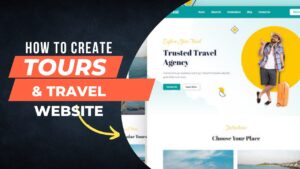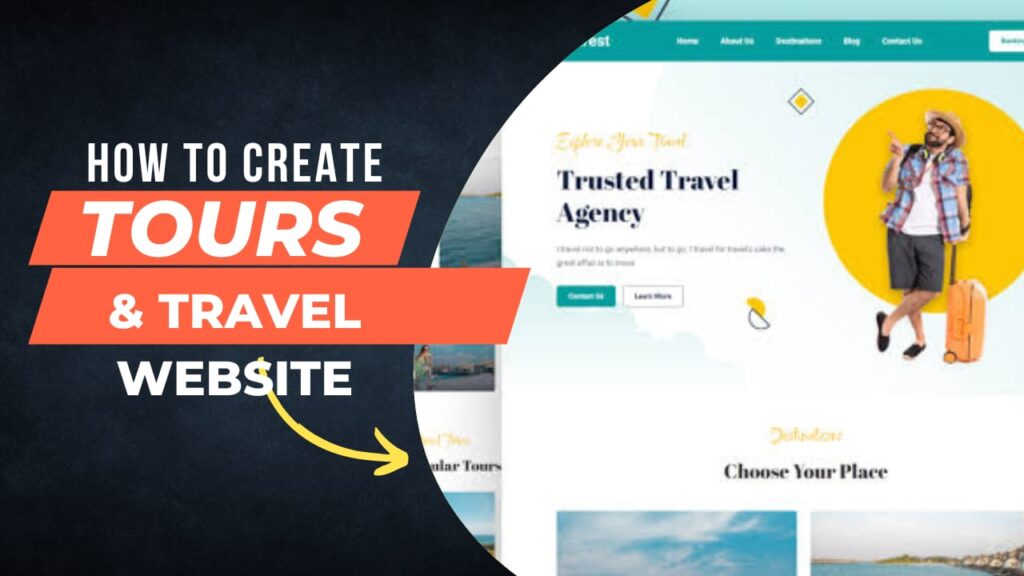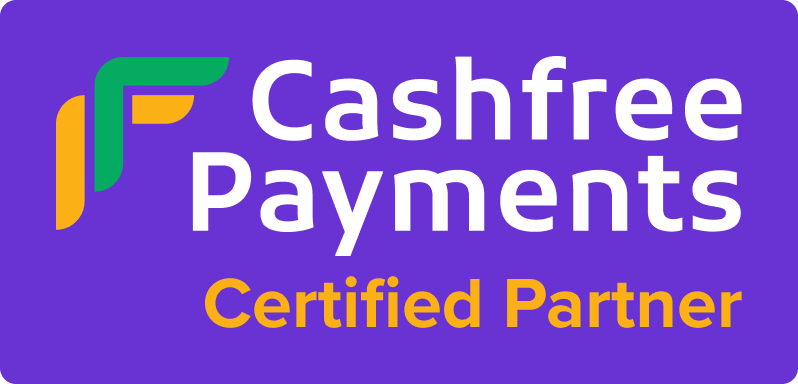Introduction: How to Create a Tours and Travel Website

Travel has become an integral part of our lives. Whether it is for leisure, adventure, or business, people are always on the move, exploring new destinations and experiencing different cultures. In this digital age, creating a website is a necessity for any business, including travel and tourism. A website helps you to showcase your business to a global audience, promote your services, and attract potential customers. In this blog post, we will discuss how to create tours and travel website that is user-friendly, attractive, and optimized for search engines.
Step 1: Choose a Domain Name
The first step in creating a website is choosing a domain name. A domain name is the web address that people will use to access your website. It should be easy to remember, unique, and relevant to your business. When choosing a domain name for your tours and travel website, consider including your business name, a keyword, or a location. For example, if your business name is ‘Travel Dreamers’, your domain name could be ‘traveldreamers.com’ or ‘dreamtravel.com’. You can use domain name registrars like GoDaddy, Bluehost, or Namecheap to check for the availability of your preferred domain name.
Step 2: Choose a Web Hosting Provider
The next step is to choose a web hosting provider. Web hosting is a service that allows your website to be accessible on the internet. There are different types of web hosting services like shared hosting, VPS hosting, dedicated hosting, and cloud hosting. Shared hosting is suitable for small businesses with low website traffic, while dedicated hosting is suitable for large businesses with high website traffic. Choose a web hosting provider that offers reliable services, 24/7 support, and affordable pricing. Some popular web hosting providers are Bluehost, SiteGround, and HostGator.
Step 3: Choose a Content Management System (CMS)
A content management system (CMS) is software that allows you to create, manage, and publish digital content on your website. There are different types of CMS available, but the most popular ones are WordPress, Joomla, and Drupal. WordPress is the most popular CMS, with over 40% of websites on the internet using it. It is easy to use, customizable, and has a large community of developers and users who offer support and plugins. Choose a CMS that is easy to use, offers customization options, and has a large community of developers and users.
Step 4: Choose a Website Template or Theme
A website template or theme is a pre-designed layout that you can use to build your website. It saves you time and effort in designing your website from scratch. There are thousands of website templates and themes available online, both free and paid. Choose a template or theme that is responsive, mobile-friendly, and matches your brand identity. Most CMS platforms like WordPress offer a wide range of templates and themes that you can choose from.
Step 5: Add Content to Your Website
The content is the most important aspect of your website. It includes text, images, videos, and other multimedia elements that convey information about your business, services, and destinations. When creating content for your tours and travel website, consider your target audience, their interests, and their needs. Use high-quality images and videos to showcase your destinations, tours, and activities. Write compelling and informative descriptions of your services, packages, and prices. Include a blog section where you can share travel tips, stories, and news.
Step 6: Optimize Your Website for Search Engines
Search engine optimization (SEO) is the process of optimizing your website to rank higher on search engine results pages (SERPs). It involves using relevant keywords, meta tags, backlinks, and other techniques to improve your website’s visibility and traffic. When optimizing your website for search engines, focus on the following elements:
- Keywords: Choose relevant keywords that your target audience is likely to search for. Use them in your website’s content, meta tags, headings, and URLs.
- Meta tags: Add meta tags to your website’s pages, including the title tag, meta description tag, and meta keywords tag. These tags help search engines understand what your website is about and what it offers.
- Backlinks: Get high-quality backlinks from other relevant websites to improve your website’s authority and ranking.
- Mobile-friendly design: Ensure that your website is optimized for mobile devices. With more than half of website traffic coming from mobile devices, a mobile-friendly website is essential for SEO.
- Site speed: Improve your website’s loading speed by optimizing images, compressing files, and using a content delivery network (CDN).
- Social media integration: Integrate social media buttons and share buttons into your website to encourage visitors to share your content on their social media profiles.
Step 7: Include Booking and Payment Features
The main purpose of a tours and travel website is to sell travel packages and services. To do this, you need to include booking and payment features on your website. You can use third-party booking systems like Expedia, Booking.com, or TripAdvisor, or you can develop your own booking system. The booking system should be user-friendly, secure, and allow customers to make payments using different payment methods like credit cards, PayPal, or bank transfers.
Step 8: Test and Launch Your Website
Once you have completed all the above steps, it’s time to test your website and launch it. Test your website’s functionality, user experience, and SEO performance. Ask your friends, family, or colleagues to test your website and provide feedback. Once you have made all the necessary changes, launch your website and start promoting it on social media, search engines, and other online platforms.
Consider below points to before you a tours and travel website :
-
How to create a tours and travel website that stands out
Creating a tours and travel website can be challenging, but with the right strategies, you can stand out from the competition. Start by choosing a unique domain name that reflects your brand and services. Then, select a web hosting provider that offers reliable and fast hosting services. To create a user-friendly website, choose a content management system (CMS) that is easy to use and customize. Finally, create high-quality content that provides value to your audience and optimize your website for search engines.
-
How to create a tours and travel website on a budget
If you’re on a tight budget, creating a tours and travel website can seem daunting. However, there are several ways to create a website on a budget. Start by choosing a low-cost web hosting provider and selecting a free or low-cost website template. To save money on content creation, write your own content or hire freelance writers. You can also use free or low-cost plugins and tools to optimize your website for search engines and improve its functionality.
-
How to create a tours and travel website that converts visitors into customers
Creating a tours and travel website that converts visitors into customers requires a strategic approach. Start by identifying your target audience and understanding their needs and preferences. Then, create high-quality content that provides value and addresses their pain points. Use persuasive copywriting techniques to encourage visitors to take action, such as booking a tour or subscribing to your newsletter. Finally, include social proof, such as customer testimonials and reviews, to build trust and credibility with your audience.
-
How to create a tours and travel website with a strong brand identity
Creating a tours and travel website with a strong brand identity is essential for building brand recognition and loyalty. Start by choosing a domain name that reflects your brand and services. Then, create a logo and choose a color scheme that aligns with your brand values and personality. Use consistent branding across your website and social media profiles to create a cohesive brand identity. Finally, create high-quality content that reflects your brand voice and values.
-
How to create a tours and travel website that is mobile-friendly
Creating a mobile-friendly tours and travel website is essential for reaching a wider audience and improving user experience. Start by choosing a responsive website template or theme that automatically adjusts to different screen sizes. Optimize your images and videos for mobile devices and use a content delivery network (CDN) to improve website speed. Finally, test your website on different mobile devices to ensure that it is user-friendly and functional.
-
How to create a tours and travel website that complies with legal requirements
Creating a tours and travel website that complies with legal requirements is crucial for avoiding legal issues and protecting your business. Start by researching the legal requirements for tours and travel websites in your country or region. Include clear terms and conditions, privacy policy, and refund policy on your website. Ensure that your booking and payment system is secure and complies with PCI DSS (Payment Card Industry Data Security Standard) requirements. Finally, consult with a legal professional to ensure that your website complies with all applicable laws and regulations.
Advantages of creating a tours and travel website :
- Increased visibility: Creating a tours and travel website can increase your online visibility and make it easier for potential customers to find your business. By optimizing your website for search engines, you can rank higher in search results and attract more visitors to your website.
- Improved customer experience: A well-designed tours and travel website can improve the customer experience by providing users with easy access to information about your services, prices, and availability. You can also include user-friendly features such as online booking and payment systems, which can save time and reduce the risk of errors.
- Expanded reach: With a tours and travel website, you can reach a wider audience and target specific geographic regions or customer segments. You can also use social media and other digital marketing channels to promote your website and attract new customers.
- Increased revenue: A tours and travel website can help you increase revenue by allowing you to sell your services directly to customers online. You can also use your website to promote packages and special deals, which can encourage customers to book with your business.
- Improved analytics and tracking: By using web analytics tools, you can track the performance of your website and gain insights into user behavior, such as which pages are most popular and which services are most in demand. This information can help you make data-driven decisions to improve your business and optimize your marketing efforts.
Disadvantages of creating a tours and travel website :
- High competition: The tours and travel industry is highly competitive, and creating a successful website can be challenging. You may need to invest significant time and resources in marketing and advertising to stand out from the competition.
- Technical knowledge required: Creating a tours and travel website requires technical skills, such as web design, programming, and search engine optimization. If you don’t have these skills, you may need to hire a web developer or agency to create and maintain your website.
- Maintenance and updates: A tours and travel website requires ongoing maintenance and updates to ensure that it remains secure and up-to-date. This can be time-consuming and may require additional resources, such as hosting and software updates.
- Security risks: A tours and travel website can be vulnerable to security risks, such as hacking and data breaches. You may need to invest in security measures, such as SSL certificates and firewalls, to protect your website and customer data.
- Customer service challenges: A tours and travel website can make it easier for customers to book your services, but it can also lead to customer service challenges, such as cancellations and refunds. You may need to have a clear refund policy and be prepared to handle customer complaints and inquiries in a timely and professional manner.



